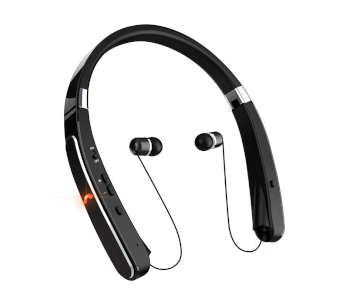Earbuds Hurt My Ears: Why this happens and what you can do
Do earbuds hurt your ears and you are looking for an alternative or a way of overcoming the problem? There are steps you can take to avoid your current earbuds causing pain, or you can invest in alternatives so that the problem doesn’t repeat itself in the future.
In this informative article we will share the solutions that can help you get a better fit that is pain-free so you can enjoy audio for prolonged durations. You’ll learn about eartips, make the right buying decision for your wearing preferences, and the alternatives that make sense.
Choose the right eartips

Solving the problem might be as simple as changing the eartips you are wearing. You typically receive 3 eartip sizes when buying earbuds, but they might not be the right size for your ears. For example, if you have very small ears, then the smallest size might not be small enough. In that case you’ll need to buy earbuds separately so that you’re able to get a good fit.
You also need to choose the right material types for your wearing preferences. Silicone is the most popular material type that the majority of brands include in the pack. The material is among the most durable and you can clean it in water without wear and tear. You can also find many silicone alternatives once the original ones wear out.
Foam is another option that is softer than silicone, which means it can minimize or eliminate the pain you experience. However, foam is not as durable, which means it will wear out sooner and you need to take good care of it. Also, it’s not a good idea to clean foam with water since it can damage the eartip overtime.
Selecting eartips that match your ear size is also important for achieving good audio quality. The in-ear fit naturally contributes towards noise isolation, which in turn allows you to enjoy good audio clarity. Therefore, you don’t have to worry about background noise interrupting your music experience.
Alternative wearing styles
The in-ear fit might not be for you. Take advantage of alternative wearing styles so that you don’t have to deal with a fit the leads to pain. Here are a few alternative wearing styles to consider:
- Over-ear: consider switching to over-ear headphones that provide good comfort with soft earpads that do not strain on your ears. Select earpads with an extra-large size that allow your entire ear to fit within the confines of the earpads. However, the over-ear fit means that you’ll need to get used to the bulky wearing style that may not always be practical. For example, when working out an in-ear fit is much better.
- On-ear: the on-ear fit is also bulkier than in-ear headphones, but less bulky than over-ear. Choose headphones with a low clamping force so not a lot of pressure is exerted on your ears.
- Bone conduction: consider the emerging technology that is bone conduction where the contact points are on the side of your head – not the ears. Therefore, there is no chance of the headphones hurting your ears, which is perfect if you want to avoid the problem altogether.
Volume
Do your ears hurt from high volume levels? The in-ear wearing format can be taxing on your ears if you have the volume turned up too high. You should only listen at high levels in very short burst. It’s best to keep the volume no higher than above average to avoid ear damage. Kid’s headphones come with volume limiting protection, but for all other audio devices you need to make the right decibel choice for yourself.
Noise isolating earbuds reduce the need to turn up the volume in noisy environments. That’s because background noise is blocked out so that you’re able to enjoy good music clarity. Furthermore, noise canceling earbuds do an even better job since background noise is actively removed by firing opposite phase sound waves.
How to tell earbud comfort before buying?
It’s best to find comfortable earbuds without going through the frustrating step of returning earbuds that hurt. Here are a few steps that you can take to help you spot comfortable earbuds:
- Images: take a look at the high-resolution images to get a sense of what materials are used and the design. You may spot strengths and weakness that can help you figure out the comfort to expect.
- Comfort features: brands tend to mention comfort-related features in the description that you should be paying attention to. They are selling points that add value to the purchase, which means they will highlight them. However, do not mistake real features for marketing tactics that do not pain the right picture.
- Customer reviews: go through customer reviews since they can be a treasure trove of information. Look for mentions of comfort which shouldn’t be too hard to find. Customers that have comfort related problems will include it in their feedback comments.
You can also visit a physical store and try the earbuds in person before buying. It may take longer, but you’ll have a better chance of ending up with the earbuds that are a good match for your ears.
Conclusion
It’s not difficult to pick out earbuds that don’t hurt your ears when you take the information above into consideration. With so much choice on the market you are sure to find an audio experience that is pain-free and matches your audio expectations.
However, even the most comfortable earbuds can result in fatigue when used daily for long periods. Take breaks as often as you can to avoid wearing out your ears and causing pain. Brands do a good job of testing their audio products before release to ensure excellent comfort is offered. Therefore, you can buy confidently without fear that pain is going to be an issue – you just need to do your homework by using the info provided in this article.


Thanks for this article! Helping me realize that the default buds were too big for my ears.